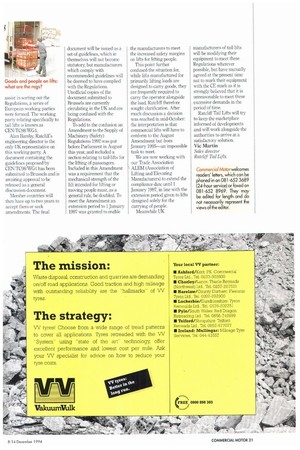Give us a break
Page 22

Page 23

If you've noticed an error in this article please click here to report it so we can fix it.
JJuring the past month IL/there has almost been a hate campaign in some regional newspapers which refer to the spate of accidents involving heavy lorries during the past year.
There have been some terrible accidents and the causes are varied and inevitably involve human error—but that is no reason to castigate the whole of the industry.
The Yorkshire Post (below) has been particularly virulent in its criticism and began a
campaign against heavy lorries to prevent continuous licensing and introduce sixmonthly brake checks. Its campaign was ill founded and obviously showed that there was little understanding of the licensing system. If continuous licensing is introduced, this will involve less paperwork both for the industry and for the Department of Transport, leaving more time for checking important items such as maintenance and safety checks--this is what everyone wants.
Ministers are ill-informed too and it is obvious that the Government today is like those in the past which have little regard for their transport industry's massive contribution to and not try to criticise and bully it out of existence.
All regional newspapers could help our readers by asking what could be done to support the transport industry and help it to improve.
Training is of paramount importance to most operators. After all, it would be insanity to give a piece of equipment worth 170,000 to a driver who does not know what he is doing or what the rules are.
A higher level of training when obtaining an HGV licence would benefit everyone and this is something the industry would welcome. Furthermore, the industry should be given the money to do this.
Port operators have also been in the news but the industry welcomes this because we too want them out of a job. Operators must stick together and support one another in an effort to get
rid of those illegal operators. So, report them to the authorities and get them out of business.
Margaret Edmunds Area manager, Road Haulage Association, Northern region.
Darlington, Co Durham.
We need time
Irefer to your article on the Supply of Machinery (Safety) Regulations 1992, Statutory Instrument No 3073/92 (CM 17-23 Nov).
These Regulations apply to the supply of machinery in general and are not specific to tail-lifts: they relate to something as small as a lawn mower up to the largest industrial processing plant The Regulations have therefore been written in general terms to cover all types of machinery and manufacturers like us have been left to interpret them to the best of our ability. To assist in sorting out the Regulations, a series of European working parties were formed. The working party relating specifically to tail lifts is known as CEN/TC98/Wa Alan Barsby, Rateliff's engineering director is the only UK representative on this working party. A document containing the guidelines proposed by CEN/TC98AVG4 has been submitted to Brussels and is awaiting approval to be released as a general discussion document.
Member countries will then have up to two years to accept them or seek amendments. The final document will be issued as a set of guidelines, which in themselves will not become statutory, but manufacturers which comply with recommended guidelines will be deemed to have complied with the Regulations. Unofficial copies of the document submitted to Brussels are currently circulating in the UK and are being confused with the Regulations.
To add to the confusion an Amendment to the Supply of Machinery (Safety) Regulations 1992 was put before Parliament in August this year, and included a section relating to tail-lifts for the lifting of passengers. Included in this Amendment was a requirement that the mechanical strength of the lift intended for lifting or moving people must, as a general rule, be doubled. To meet the Amendment an extension period to 1 January 1997 was granted to enable the manufacturers to meet the increased safety margins on lifts for lifting people.
This point further confused the situation for, while lifts manufactured for primarily lifting loads are designed to carry goods, they are frequently required to carry the operator alongside the load. Rateliff therefore sought clarification. After much discussion a decision was reached in mid-October: the interpretation is that commercial lifts will have to conform to the August Amendment but from January 1995—an impossible task to meet.
We are now working with our Trade Association ALEM (Association of Lifting and Elevating Manufacturers) to extend the compliance date until 1 January 1997, in line with the extension period given to lifts designed solely for the carrying of people.
Meanwhile UK manufacturers of tail-lifts will be modifying their equipment to meet these Regulations wherever possible, but have mutually agreed at the present time not to mark their equipment with the CE mark as it is strongly believed that it is unreasonable to meet these excessive demands in the period of time.
Ratcliff Tail Lifts will try to keep the marketplace informed of developments and will work alongside the authorities to arrive at a satisfactory solution.
Vic Martin Saks director Ratcl Tail Lifts.
























































































